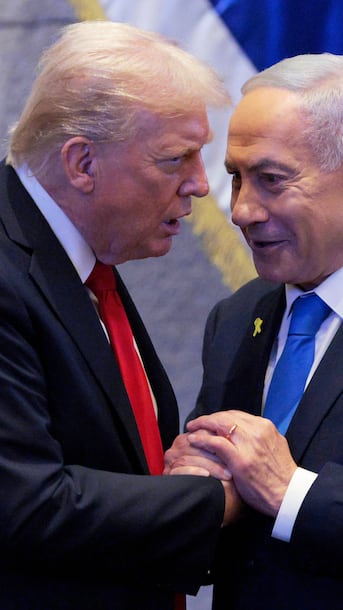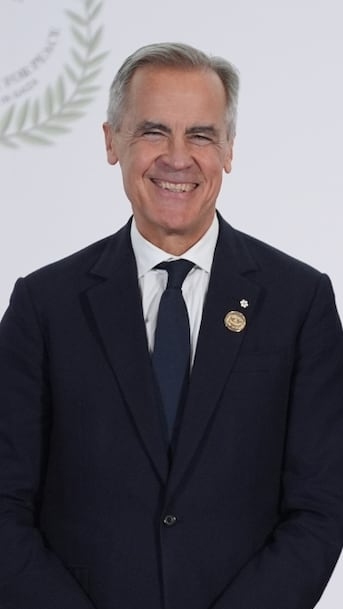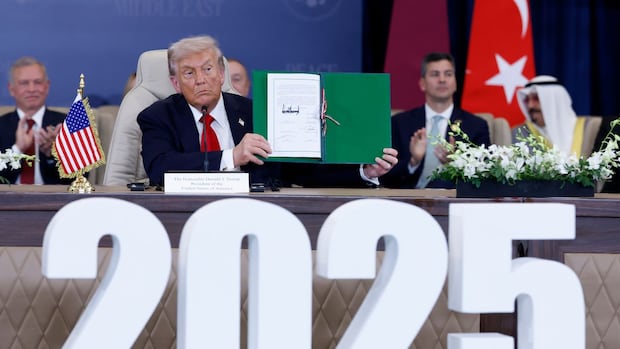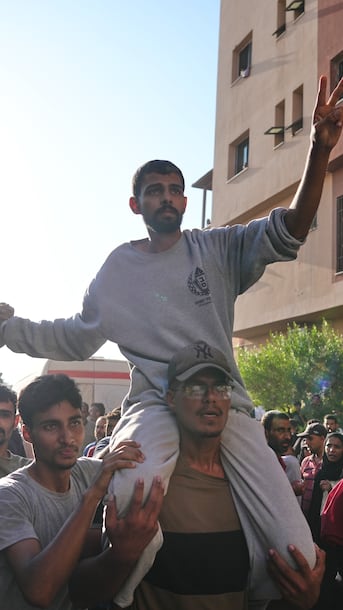US President Donald Trump began a quick trip to the Middle East on Monday to confirm the end of the war between Israel and Hamas, and to confirm his ambitions to achieve peace between the two parties.
His visits included the Israeli Knesset in Jerusalem and a global summit in Egypt – all while Hamas and Israel underwent a long-awaited prisoner and hostage exchange as part of a ceasefire that halted the violent conflict.
Monday was a day filled with celebration, relief, and some uncertainty. Here’s everything you might have missed.
Trump addresses the Israeli parliament.
Trump visits Israel
Trump visited Israel early in the day to celebrate the US-brokered ceasefire with Hamas.
He delivered a speech in the Knesset and described the day as “a new dawn for the Middle East.”
Israeli lawmakers chanted Trump’s name and applauded him several times. Some people in the audience wore red “Make America Great Again” hats similar to his, although these versions said “Trump, Peace President.”
Israeli Prime Minister Benjamin Netanyahu praised Trump as “Israel’s greatest friend ever in the White House,” and promised to work with him moving forward.
Netanyahu said: “Mr. President, you are committed to this peace. I am committed to this peace.” “And together, Mr. President, we will achieve this peace.”
US President Donald Trump and Israeli Prime Minister Benjamin Netanyahu praised each other on Monday for the success of the first phase of the peace plan between Israel and Hamas.
Trump, in an unexpected turn during his speech, called on the Israeli president to pardon Netanyahu, whom he described as “one of the greatest” wartime leaders. Netanyahu faces corruption charges, although several hearings were postponed during the conflict with Hamas.
The Republican president also used the opportunity to settle political scores and thanked his supporters, criticizing his Democratic predecessors and praising one of the major donors, Miriam Adelson, who was in the audience.
Trump flies to Sharm El Sheikh
After his stop in Israel, Trump headed to Sharm El-Sheikh in Egypt to meet with Egyptian President Abdel Fattah El-Sisi before the summit of world leaders. At that meeting, Trump, along with the mediators, signed the document formally ending the war in Gaza.
Trump and Sisi spoke together to reporters.
“Everyone said it couldn’t be done,” Trump said of his peace deal. “And it’s happening before your eyes.”
Trump said that Egypt played a “very important role” in the ceasefire negotiations, especially with Hamas.
Trump and mediators sign the peace agreement
Nearly thirty countries, including some from Europe and the Middle East, were represented at the international summit in Sharm El Sheikh.
Trump, Sisi, Turkish President Recep Tayyip Erdogan and Qatari Emir Tamim bin Hamad Al Thani signed the document, which Trump said would lay the foundation for Gaza’s future. A copy has not been released to the public.
Palestinian leader Mahmoud Abbas was in Egypt, as was Canadian Prime Minister Mark Carney, whom Trump referred to as “the president.”
During his speech at the Gaza Peace Summit in Egypt, US President Donald Trump referred to Prime Minister Mark Carney as “president.” Carney attended the signing of the peace plan aimed at ending the war in Gaza, along with other world leaders.
After the meeting, Carney posted on X that the event represented a “An important new chapter.”
He added: “We are focused on the next steps to achieve peace and security in the Middle East, including ensuring the urgent delivery of life-saving aid.” Carney wrote on X.
Notably, Netanyahu declined an invitation to attend the summit, as his office said it was too close to a Jewish holiday. according to Some reportsTurkish Erdogan He said that he would not land his plane in Sharm El-Sheikh if Netanyahu attended, but it is unclear whether that influenced Netanyahu’s decision.
Worrying about what lies ahead
The most recent state of war began when Hamas-led militants launched a surprise attack on southern Israel on October 7, 2023, in which about 1,200 people, mostly civilians, were killed, and 251 were taken hostage.
The ensuing two-year war destroyed the Gaza Strip, including its health infrastructure, and killed tens of thousands of Palestinians, including children. Several humanitarian organizations said famine had spread across the region, and Israel had repeatedly blocked aid. About 90% of Gaza’s population of two million people have been displaced.
The situation in Gaza sparked international protests and allegations of genocide, which Israel denies.
On the same day that the ground attack on Gaza City was launched, a UN Commission of Inquiry report concluded that Israel had committed genocide in Gaza, a finding that Israeli officials categorically denied.
This is why experts warn that the repair and reconstruction process will be difficult.
Nader Hashemi, a professor of Middle East politics at Georgetown University, told CBC News that he believes the belief that Monday’s events indicate the possibility of broader regional peace is a “gross distortion.”
Al-Hashimi said: “This peace plan that Donald Trump is promoting as the best peace plan in thousands of years was a peace plan that was made where neither side of the conflict – the Palestinians – had any voice.” “It was largely an Israeli peace plan crafted with the cooperation of the Trump administration and input from Arab dictators.”
Al-Hashemi hopes to achieve peace and reconciliation between Palestinians and Israelis “on the basis of equality, safety and security,” but he says, “This is not the plan that will get us there.”
Nader Hashemi, professor of Middle East politics at Georgetown University, welcomes the ceasefire agreement between Israel and Hamas brokered by the United States. But he says he remains skeptical that the agreement alone will mean lasting peace, because it lacks the necessary details.
“The real tough questions are what happens next?” Whether the Trump administration has the strength and political stamina to achieve this remains to be seen. The former United Nations Special Rapporteur for human rights in the occupied Palestinian territories, He told CBC News.
Link added that Trump’s widely circulated 20-point plan is full of ambiguity and does not rely sufficiently on international law and UN resolutions related to Israel and the occupied Palestinian territories.
He said the plan also failed to chart a path to a two-state solution, which many had called for. For Netanyahu, establishing a Palestinian state is not the beginning.
Link also said that the devastation in Gaza – and therefore reconstruction – poses a major challenge.
“It is a huge task facing the international community about how to get the money, how to organize the reconstruction process, and whether the Palestinians will want to stay in the medium or long term.”
For his part, Trump said that “a lot of money is coming into Gaza.” But he did not provide details.
The next steps are unclear
Questions abound about next steps: Trump offered few details about what’s to come.
Israel and Hamas are still in the early stages of implementing the first phase of Trump’s plan.
In addition to the exchange of hostages and prisoners, the first phase calls for increased humanitarian aid to Gaza and a partial withdrawal of Israeli forces from major cities in Gaza.
Israel has reportedly agreed to reopen five border crossings, which will help facilitate the flow of much-needed food and other supplies into Gaza.
All 20 living Israeli hostages were released on Monday, the first step in a ceasefire agreement signed with Hamas. Maureen Leshem, whose cousin was held by Hamas for 15 months and then released in January, says the release of all the hostages brings “overwhelming relief.”
Many other details have not been resolved, such as the post-war governance of Gaza, how to handle the reconstruction process, and Israel’s demand to disarm Hamas.
Negotiations on these issues may collapse, and Israel has hinted that it may resume military operations if its demands are not met.
However, Monday was full of celebration and relief.
Release hostages and prisoners
Cheering crowds greeted buses of released prisoners in the West Bank and Gaza Strip, while families and friends of the hostages gathered in a square in Tel Aviv, Israel. He shouted with joy and relief With the arrival of news of the release of prisoners.
Crowds of Palestinians gathered in front of Nasser Hospital in the city of Khan Yunis, to receive nearly 2,000 prisoners and detainees released from Israeli prisons, today, Monday. One aid coordinator says the question now is whether Palestinians are free to leave Gaza safely.
All 20 living Israeli hostages held by Hamas and hundreds of Palestinian prisoners held by Israel were released on Monday. Hamas said on Monday that it would hand over the bodies of four of the 28 deceased prisoners, but it was not immediately clear when the rest would be released.
Israel said it had released more than 1,900 Palestinian prisoners as part of the ceasefire agreement in Gaza.
https://i.cbc.ca/ais/c306971c-0cec-4f0d-8211-1d345dd27cc5,1760389131562/full/max/0/default.jpg?im=Crop%2Crect%3D%280%2C0%2C3663%2C2060%29%3BResize%3D620
Source link






